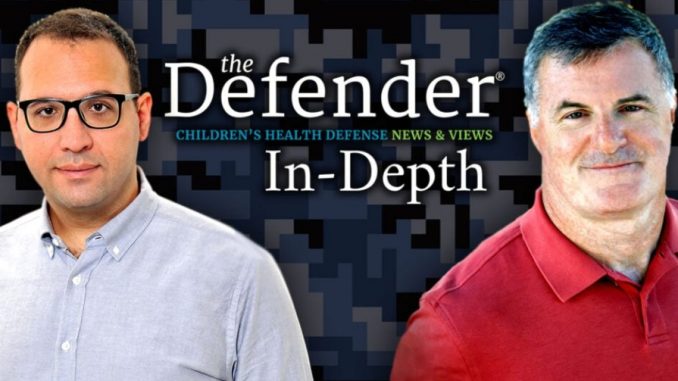
The panic of the COVID pandemic changed the world.
People lost their lives or knew and/or loved someone who did. During the 2019-2022 COVID pandemic, everyone thought at least once, if not once a day, maybe once a week, once a month, or more, that “maybe I’m next.” Then, the media stepped in and enlarged the fears, adding distrust of every scientist, government official, or other spokesperson attached to the COVID-19 vaccine. Or, the opposite: scientists and lawyers became media stars, with the “most” believable person obtaining a million more viewers than someone else. People of the opposing camp marketed hate for the other side. The media idolized those who looked good and could talk quickly and well. In this scenario, you are who you look like.
Under the umbrella of fear, the thought police started rounding up anyone who disagreed with them. Workers turned on others in their workspace. Administrators fired those who refused to agree with them. Instead of throwing out good people from their jobs, we could have tried accommodating and respecting all reasons for not getting vaccinated and put value on that accommodation or exemption.
That did not happen.
We must hold the Federal, state, and local governments accountable for their actions, not only for harming the thousands who have lost their purpose, job, home, and family, but also for attacking a single individual anywhere and everywhere who tried their best to figure out how to survive. Every single person who stood up to claim their rights to life, liberty, and the pursuit of happiness must be compensated and get all the backpay and benefits that are due. All of us still standing and cheering them on will benefit from their win.
I have posted the article below as part of my effort to be part of that.
Betsy Combier
betsy@advocatz.com
Editor, Parentadvocates.org
Editor, New York Court Corruption
Editor, National Public Voice
Editor, NYC Public Voice
Editor, Inside 3020-a Teacher Trials
Watch: Military’s COVID Vaccine Mandate ‘Illegal’ Lawyer Says
This week’s edition of “The Defender In-Depth” featured an interview with Dale Saran, lead attorney in three class-action lawsuits seeking potentially billions of dollars in back pay and the correction of records for U.S. military service members who were discharged for refusing the COVID-19 vaccine.
By
This week’s edition of “The Defender In-Depth” featured an interview with Dale Saran, lead attorney in three class-action lawsuits seeking potentially billions of dollars in back pay and the correction of records for U.S. military service members who were discharged for refusing the COVID-19 vaccine.
The armed services implemented a COVID-19 vaccine mandate on Aug. 24, 2021, which was rescinded on Jan. 10, 2023.
Saran said the mandate was illegal, as under federal law, only fully licensed vaccines can be mandated to service members. The only available COVID-19 vaccines were those issued under Emergency Use Authorization (EUA).
The three lawsuits — Bassen v. The United States of America, Botello v. The United States of America and Harkins v. The United States of America — are before the U.S. Court of Federal Claims.
Saran, a retired marine officer who previously litigated other cases challenging COVID-19 vaccine mandates in the military, told “The Defender In-Depth” that when the military’s COVID-19 vaccine mandate was rescinded, “It was time, we thought, to go and try and get recompense for all those who had been discharged, kicked out or otherwise had their rights trampled.”
He also noted that the military, which is facing a recruitment crisis and is now attempting to woo back unvaccinated service members it previously discharged, is “disingenuous” in doing so, as the reenlistment process for these service members is fraught with obstacles that he says the military has intentionally created.
Saran said that the military’s “sham” religious accommodation process, in which practically no religious exemptions to the vaccine mandate were granted, has played a role in the military’s decreased recruitment numbers.
‘Illegal’ to claim EUA vaccines ‘interchangeable’ with licensed vaccines
According to Saran, the military implemented its COVID-19 vaccine mandate one day after the first COVID-19 vaccine, Pfizer’s Comirnaty, was fully licensed by the U.S. Food and Drug Administration. “The same day that [Comirnaty] was licensed, it was also removed from the U.S. market,” Saran said.
“Yet, they made military folks, or ordered them, to take it,” he said, noting that the U.S. Department of Defense (DOD) declared in September 2021 that the vaccines available under an EUA were “interchangeable” with the fully licensed vaccines.
Saran said there isn’t “any authority whatsoever for somebody in the DOD to declare that a licensed biologic is equivalent to an unlicensed biologic product. That’s all governed by federal statutes that have been around since 2008.”
“It’s patently illegal. It was just completely unlawful to do so,” Saran said.
According to Saran, Congress had explicitly passed a statute that forbids the mandating of unlicensed products unless the president of the United States explicitly waives members’ rights to informed consent. “This was not the case with the COVID-19 vaccines,” he said.
A November 2021 federal court ruling also rejected the DOD’s “interchangeability” claim.
Noting that EUA products are covered by a liability shield under the Public Readiness and Emergency Preparedness Act (PREP Act) — which does not exist for licensed products — Saran said the military’s actions resemble “a bait-and-switch … to protect the pharmaceutical companies at the expense of the military.”
Religious accommodations policy akin to a ‘religious targeting policy’
According to Saran, a significant number of military service members objected to the COVID-19 vaccine mandate on religious grounds and sought a religious exemption.
Yet, “The military did not handle the religious accommodation process very well at all, and that’s an understatement, which is to say they made a mess of it,” Saran said. “There was no religious accommodation policy. In fact, it looks like it was a religious targeting policy” that violated the Religious Freedom Restoration Act.
Saran said what the military set up “is just this sham, a kabuki theater” that “wasn’t a real accommodation process” and where “the answer was always going to be no.”
“The entire process was a fraud,” he said. There was no individual assessment done, although Saran said there were numerous instances where individual military members who were unvaccinated “weren’t allowed to go into the chow hall [or] had to wear different colored wristbands” to set them apart.
Military not being honest in trying to woo back unvaccinated service members
Responding to the news that the U.S. Army sent letters to unvaccinated former service members, offering them the opportunity to request corrections to their service records or to reenlist, Saran said the Army is not being honest.
“All these people that they dropped or discharged, they gave bad reenlistment codes or they gave a general [not honorable] discharge … they gave them letters of reprimand, … a big chunk of them aren’t even eligible to reenlist,” Saran said, adding that the process to correct their records may span at least 18 months to two years.
Yet, when the military’s “Don’t Ask, Don’t Tell” policy was repealed in 2011, records of service members who were discharged under that policy were automatically corrected.
“If the secretaries really wanted people back, they have the authority,” Saran said. Yet, “they’re making people that they supposedly want back beg and grovel to come back.”
Saran said that total back pay owed to the service members who were discharged or otherwise let go due to their unvaccinated status may total billions of dollars. He explained how he and his legal team arrived at that figure.
“What we did was go through all of the [National Defense Authorization Act] bills and see how much the military had appropriated for the pay and benefits for those members of the military,” he said. “And then it was a matter of just crunching all those numbers.”
“No matter how you do it, we can’t come up with a number that’s any less than $4 billion, and it could be as high as $15 billion or more.”




Be the first to comment